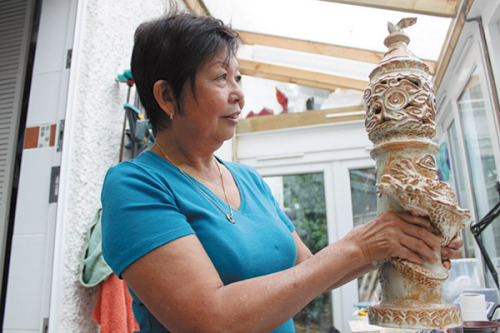
British ceramics artist Jessie Lee with her first work, a candlestick she made 40 years ago.(Photo provided to China Daily)
When Li attended the International Ceramics Festival, held in July in Aberystwyth on the coast of west Wales, the Chinese artwork and handmade pottery tools she took along attracted huge interest.
"During the three-day event, my stand was crowded all the time. People were asking me about Jingdezhen and traditional Chinese skills," she said.
"In 2013, I was invited to give a speech on our institution and Jingdezhen's ceramic arts at the festival. Next time, I hope to bring more Chinese potters to the UK's leading ceramics event."
After Jingdezhen's potters discovered the secret of making porcelain during the Song Dynasty (960-1279), the material became one of China's earliest and most important global commodities, and helped introduce Chinese culture, art and the name of the city to the world. Even today, Jingdezhen is a byword for ceramics.
Although the industry has modernized and many of the old processes are now performed by machines, the city's ancient kilns and skills have been lovingly preserved.
Built during the Qing Dynasty (1644-1911), the 40-meter-long Zhenyao is in the Guinness Book of World Records as the world's largest wood-burning kiln, and it is still regularly used to fire porcelain.
In 2005, a blue and white jar that had been fired in Huluyao-another active ancient kiln in Jingdezhen during the Yuan Dynasty (1271-1368)-sold for $34 million at an auction in London.
"For ceramic artists, Jingdezhen is like a gold mine-there are so many things to learn. An ordinary old man walking on the street might be a master of the wood-burning kiln," Li said, adding that in the UK, ceramists focus on having good ideas, but very few of them understand glazes and related skills, including throwing, coiling and painting.
Potters use the past to inspire them in the future
Jessie Lee believes China's long history of ceramics is both a cause for celebration and a curse for the country's contemporary artists.
"How can they surpass the peak that people achieved during the Tang (AD 418-907) and Song (960-1279) dynasties? Sometimes when you are too good at something, you may be afraid of making new things. Many of the works I saw in Jingdezhen were imitations of ancient works," the Malaysian-born British ceramics artist said.
"In the UK, we don't have that much history and tradition (of ceramics), so it is easier for us to create and innovate. I think China's ceramic artists should also investigate new approaches and embrace new technology."
Wang Yuwei is studying for a master's degree in architecture and ceramics at University College, London. The 24-year-old student said teachers in the UK encourage experimental projects and the use of new materials.


















































